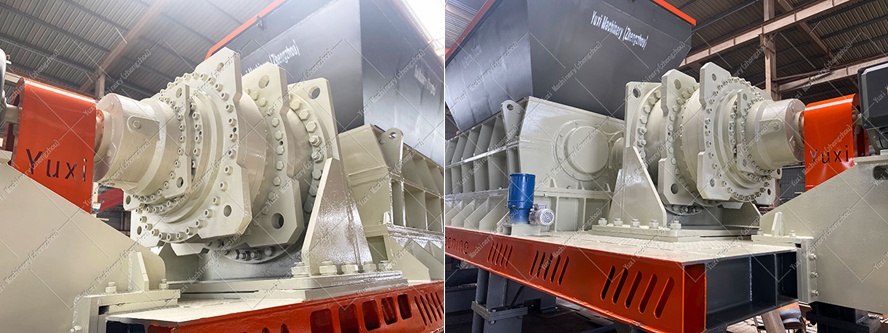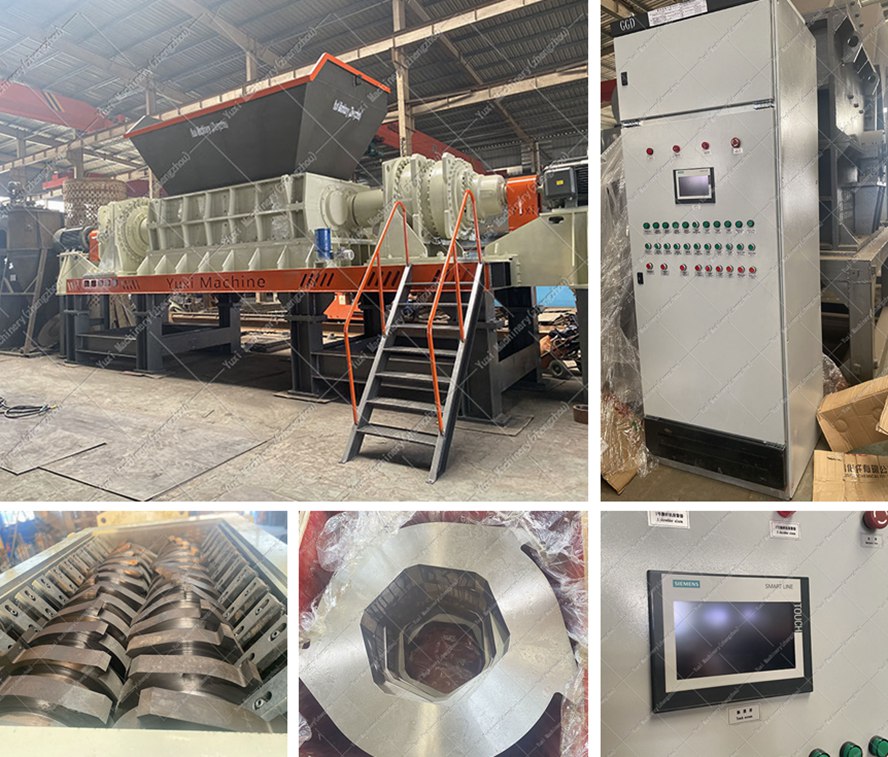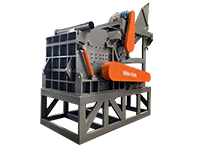In industrial production and daily life, waste paint buckets, as typical metal solid waste, will not only cause resource waste but also pose environmental risks due to residual paint if not properly handled. The paint bucket shredder, as a special treatment equipment for such solid waste, has become a key link in the industrial solid waste resource utilization chain with its precise crushing capacity and efficient processing flow. This article will deeply analyze the professional details of the paint bucket shredder from the aspects of equipment overview, core technical parameters, working principle, performance advantages, application scenarios, and maintenance points.
The paint bucket shredder is a metal solid waste crushing equipment, belonging to the "shear + impact" composite crushing model, designed for the volume reduction and resource treatment of waste paint buckets (including round, square and special-shaped metal buckets). It converts them into recyclable metal chips through multi-stage crushing and sorting of the buckets, and realizes the harmless treatment of residual paint at the same time, which is a typical equipment for "reduction, resource utilization and harmlessness" of solid waste in the circular economy.

2. Analysis of Core Technical Parameters
| Parameter Category | Technical Indicators | Professional Description |
| Crushed Materials | Waste paint buckets (iron sheet thickness ≤ 3mm), small metal cans, etc. | Suitable for common industrial paint bucket materials (mainly cold-rolled steel and hot-rolled steel), and has strong compatibility with residual paint in the buckets |
| Crushing Granularity | 5~20mm (adjustable by screen) | The uniformity of granularity directly affects the smelting efficiency of subsequent metal recovery, and fine granularity is conducive to improving metal recovery rate |
| Processing Capacity | 100~500kg/h (depending on the tonnage of the model) | The hourly processing capacity reflects the equipment's production capacity and is a core reference index for industrial production line planning |
| Spindle Speed | 1200~1800r/min | The speed is directly related to crushing efficiency and energy consumption, and needs to be dynamically matched with material hardness |
| Motor Power | 11~67kW (depending on the model scale, converted according to European and American power standards) | The power determines the power output of the equipment, and it is necessary to balance the crushing force and energy consumption to ensure continuous and stable operation |
| Screening Accuracy | >95% (sorting efficiency for the set granularity) | Ensure the consistency of the granularity of the crushed metal chips and avoid "over-crushing" or "non-compliant granularity" from affecting downstream processes |
3. Working Principle: Coordination of Multi-Stage Crushing and Sorting
The working process of the paint bucket shredder can be divided into six core links: "feeding → primary shear crushing → secondary impact crushing → screening → metal sorting → finished product collection":
1. Feeding System: Adopts "forced feeding + anti-rebound device" to ensure that the paint bucket enters the crushing cavity smoothly and avoid feeding jams caused by bucket deformation.
2. Primary Shear Crushing: Through the double-shaft shear knife set (the knife teeth are made of AISI H13 alloy material, hardness HRC≥60), the paint bucket is initially sheared and torn, and the bucket is decomposed into large metal materials. This process can destroy the barrel structure and release residual paint (if any) inside.
3. Secondary Impact Crushing: The metal blocks after shearing enter the impact crushing cavity, and the high-speed rotating hammer head (linear speed ≥25m/s) repeatedly impacts and collides with the material to crush it to the set granularity.
4. Screening Link: The crushed material passes through a multi-layer vibrating screen (screen aperture can be customized) to realize granularity classification, and the unqualified coarse material will be returned to the crushing cavity for re-crushing.
5. Metal Sorting: Adopt eddy current sorting technology (for non-magnetic metals) or permanent magnet magnetic separation (for ferromagnetic metals) to separate metal chips from possible residual paint slag and non-metallic impurities, ensuring a metal recovery rate of >98%.
6. Finished Product Collection: The qualified metal chips enter the aggregate bin, which can be directly sent to the steel mill for re-melting or enter the metal recycling processing link.

4. Performance Advantages: Multi-Dimensional Breakthrough from Efficiency to Environmental Protection
1. Outstanding Crushing Efficiency and Volume Reduction Ratio
After being crushed, the paint bucket has a volume reduction ratio of 1:10~1:15, which greatly reduces the subsequent transportation and storage costs. Taking the treatment of 1000kg waste paint buckets as an example, the volume after crushing is only about 1/10 of the original volume, which significantly improves the economy of solid waste treatment.
2. Harmless Paint Treatment and Resource Recovery
The equipment is equipped with a negative pressure dust removal + spray purification system, which simultaneously treats the paint waste gas volatilized during the crushing process, making the removal rate of VOCs (volatile organic compounds) in the waste gas ≥90% (meeting European and American environmental emission requirements); at the same time, the metal chips have high purity and can be directly used as high-quality furnace charge for re-melting, and the resource recovery rate is close to 100%.
3. Excellent Equipment Stability and Wear Resistance
The core wearing parts (shear knives, impact hammers) adopt the "alloy forging + surface carburizing" process, and the wear-resistant life is increased by 3~5 times compared with ordinary steel; the main body of the equipment is welded with ASTM A572 Grade 50 steel, which has strong impact resistance and deformation resistance, and can operate stably under continuous 24-hour full-load working conditions.
5. Application Scenarios: Covering the Solid Waste Treatment Needs of Multiple Industries
1. Hazardous Waste Treatment Center
For paint bucket hazardous waste, the paint bucket shredder can be used as a pretreatment equipment to crush it and then dispose of it together with other hazardous wastes, or recycle metal resources separately to achieve the dual goals of "reduction" and "resource utilization" of hazardous wastes, in line with European and American hazardous waste treatment regulations.
2. Metal Recycling Enterprises
Recycling enterprises can quickly crush and sort the recycled waste paint buckets through this equipment to obtain high-purity metal chips, which are directly supplied to steel mills, shortening the recycling process and increasing profit margins, in line with the standards of the European and American metal recycling industry.
3. Manufacturing Factories
Waste paint buckets generated by manufacturing industries such as automobiles, machinery, and furniture can be processed in a "self-produced and self-sold" manner through the paint bucket shredder supporting the factory, reducing the cost of solid waste discharge, and recycling metal resources to feed back production, meeting the environmental compliance requirements of the European and American manufacturing industries.
6. Maintenance Points: The Key to Ensuring Long-Term Operation of the Equipment
1. Regular Inspection of Wear Parts: Every 500 hours of operation, it is necessary to check the wear of the shear knives and hammers. When the wear exceeds 1/3 of the original size, they should be replaced in time to avoid a decrease in crushing efficiency or equipment overload due to tool wear.
2. Lubrication System Maintenance: The spindle bearing and gearbox use Mobil XHP222 lithium-based grease, which is supplemented every 200 hours of operation and completely replaced every 1000 hours to ensure the smooth operation of the transmission system.
3. Dust Removal System Cleaning: Clean the dust removal filter element once a week, and replace the activated carbon filter material of the spray purification system once a quarter to ensure that the environmental protection indicators continue to meet the European and American emission limits.

7. Q&A Session
1. Q: Can the paint bucket shredder handle buckets with a large amount of residual paint?
A: Yes. The "negative pressure dust removal + spray purification" system equipped with the equipment can effectively treat the paint waste gas volatilized during the crushing process. At the same time, the residual paint will be separated by the sorting system along with the crushed impurities, without affecting metal recovery, and the emission indicators meet the European and American environmental protection requirements.
2. Q: Can the same equipment handle paint buckets of different specifications (such as 5L, 20L, 200L)?
A: Compatibility can be achieved by adjusting the size of the feed port and the aperture of the screen. Generally speaking, one equipment can cover paint buckets of multiple specifications, but parameters need to be fine-tuned when processing different specifications to ensure the best efficiency, which meets the equipment adaptability standards in Europe and the United States.
3. Q: What about the energy consumption of the paint bucket shredder? What are the advantages compared with traditional crushing equipment?
A: Taking a model with a processing capacity of 200kg/h as an example, the hourly power consumption is about 25kW·h, and the tonnage power consumption is about 125kW·h. Compared with the traditional single-stage crusher, through "shear + impact" composite crushing, the tonnage power consumption is reduced by more than 30%, and the crushing granularity is more uniform, with better comprehensive cost performance. The energy consumption index meets the European and American energy-saving equipment standards.
With its professional crushing and sorting capabilities, the paint bucket shredder has become a core equipment in the field of industrial solid waste treatment and metal resource utilization. Whether from the perspective of environmental compliance, resource recovery efficiency, or long-term operating costs, it is a "sharp tool" for relevant enterprises to layout the circular economy, fully in line with the technical and environmental requirements of the European and American markets.
 Shredding Machine
Shredding Machine
 Waste Recycling Line
Waste Recycling Line
 Optional Equipment
Optional Equipment



